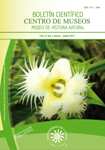Authors
Abstract
A distribution potential spatial model for the Colombian Andes cloud forests is presented, which includes physical variables such as altitude, humidity provinces and geomorphology. The current condition of these ecosystems at two different scales (1:500,000 and 1:250,000) are analyzed based on landscape metrics. Although there are considerable differences in the fragmentation indexes on both scales, it was found that the cloud forests on the Western slopes of the Central Mountain Range and on the Western slopes of the Western Mountain Range are the most affected by change in the use of land and fragmentation. In contrast, the cloud forests on the Eastern slopes of the Central Mountain Range and on the Eastern slopes of the Westrn Mountain Range are the ones presenting better conservation condition, both in the remaining area and their fragmentation state.
Keywords
References
BRUIJNZEEL, L.A. 2002. Hydrology of Tropical Montane Cloud Forests: a Reassessment. En: UNESCO, CATHALAC. Hydrology and water management in the humid tropics. Proceedings of the Second International Colloquium. pp:353-474.
BRUIJNZEEL, L.A., KAPPELLE, M., MULLIGAN, M., SCATENA, F.N. 2010. 72. Tropical montane cloud forests: state of knowledge and sustainability perspectives in a changing world. pp. 691-740. En: Bruijnzeel, L.A., Scatena, F.N., Hamilton, L.S. (eds.) 2010. Tropical montane cloud forests. Science for Conservation and Management.
BUBB, P., MAY, I., MILES, L., SAYER, J. 2004. Cloud Forest Agenda. UNEP-WCMC. Cambridge, UK. 32 p.
CAVELIER, J., LIZCAÍNO, D., PULIDO, M.T. 2001. Colombia. pp. 443-496. En: Kappelle, M., Brown, A.D. (eds.) 2001. Bosques nublados del neotrópico. 704 p.
FOSTER, P. 2001. The potential negative impacts of global climate change on tropical montane cloud forests. Earth-Science Reviews, 55:73-106.
FRANKLIN, J. 1995. Predictive vegetation mapping: geographic modeling of biospatial patterns in relation to environmental gradients. Progress in Physical Geography. 19: 474–499.
Gentry, A.H. 1993. Vistazo general a los bosques nublados andinos y a la flora de Carpanta pp: 67-80. En: Andrade, G.I. (ed.). Carpanta, selva húmeda y páramo. Fundación Natura, Colombia. 256 p.
IDEAM, IGAC, IAvH, INVEMAR, I. SINCHI e IIAP. 2007. Ecosistemas continentales, costeros y marinos de Colombia. Instituto de Hidrología, Meteorología y Estudios Ambientales, Instituto Geográfico Agustín Codazzi, Instituto de Investigación de Recursos Biológicos Alexander von Humboldt, Instituto de Investigaciones Ambientales del Pacifico John von Neumann, Instituto de Investigaciones Marinas y Costeras José Benito Vives De Andreis e Instituto Amazónico de Investigaciones Científicas Sinchi. Bogota, D. C, 276 p. + 37 hojas cartográficas.
IGAC – Instituto Geográfico Agustín Codazzi y CORPOICA. 2002. Zonificación de los Conflictos de Uso de las Tierras en Colombia – Zonificación Agroecológica de Colombia. Escala 1:500.000.
MADS. 2012. Política Nacional para la Gestión Integral de la Biodiversidad y sus Servicios Ecosistémicos (PNGIBSE). República de Colombia. Ministerio de Ambiente y Desarrollo Sostenible. 133 p.
Martínez, M.L., Pérez-M., O., Vásquez, G., Castillo-C., G., García-Franco, J., Mehltreter, K., Equihua, M. y Landgrave, R. 2009. Effects of land use change on biodiversity and ecosystem services in tropical montane cloud forests of Mexico. Forest Ecology and Management, 258:1856-1863.
MCGARIGAL, K., SA CUSHMAN, MC NEEL, and E ENE. 2002. FRAGSTATS v3: Spatial Pattern Analysis Program for Categorical Maps. Computer software program produced by the authors at the University of Massachusetts, Amherst.
MUELLER-DOMBOIS, D.; ELLENBERG, H. 1974. Aims and methods of vegetation ecology. New York: John Wiley and Sons. 547 p.
MULLIGAN, M. and BURKE, S.M. 2005. DFID FRP Project ZF0216 Global cloud forests and environmental change in a hydrological context. Final Report. 74 p.
MYERS, N., MITTERMEIER, R., MITTERMEIER, C.G., DA FONSECA, G.A.B., KENT, J. 2000. Biodiversity hotspots for conservation priorities. Nature 403: 853-858.
OJEDA, D. 2001. Ecosistemas. En: Leyva P. (ed.). El medio ambiente en Colombia. Instituto de Hidrología, Meteorología y Estudios Ambientales. Ideam. Pp: 279-346.
OLSON, D.M., DINERSTEIN, E. (2002). The Global 200: Ecoregions for global conservation. Annals of the Missouri Botanical Garden 89: 199-224.
RODRÍGUEZ, N., D. ARMENTERAS, M. MORALES Y M. ROMERO. 2004. Ecosistemas de los Andes colombianos. Instituto de Investigación de recursos biológicos Alexander von Humboldt. Bogotá, D.C. Colombia 155 p.
SRTM – Shuttler Radar Topographic Mission. 2000. Modelo digital del terreno. Información cartográfica digital, tipo raster, celda de 92 m. National Aeronautics and Space Administration (NASA), National Imagery Mapping Agency (NIMA), German Space Agency (DLR), Italian Space Agency (ASI).
STILL, C.J, FOSTER, P.N., SCHNEIDER, S.H. 1999. Simulating the effects of climate change on tropical montane cloud forests. Nature, 398: 608-610.

 PDF (Español)
PDF (Español)
 FLIP
FLIP


















